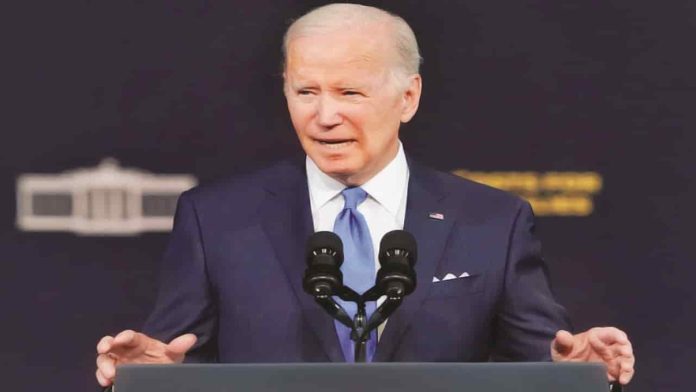By Kenneth Tiven
Within hours of a victory statement by Republican House of Representatives leader Kevin McCarthy, his right-wing MAGA caucus was complaining. At the same time, Democrats continued to smile like the Cheshire cats in Alice in Wonderland. Signing the bill, US President Joe Biden said: “Passing this budget agreement was critical. The stakes could not have been higher, no one got everything they wanted, but the American people got what they needed. We averted an economic crisis and an economic collapse.”
The New York Times reporter Peter Baker summed up the deal math as a president refusing to inflame Republicans. His reticence stood in striking contrast to his negotiating partner, Speaker Kevin McCarthy, who has been running all over the Capitol in recent days asserting that the deal was a “historic” victory for fiscal conservatives.
In the Senate, centrist Democrats and Republicans united 63 to 36 to approve the House bill’s two-year delay on debt-ceiling matters, moving the contentious issue beyond the 2024 presidential election. Democrats opposed on principle to cutting social benefits to ordinary Americans maintained their moral high ground without hurting Biden’s win. Two days previously, the approval in the House had been 314 to 117.
The Congressional Budget Office projects the legislation will reduce the deficit by $1.5 trillion over the next decade. Conservative Republicans demanding more punitive cuts voted against it. Liberal Democrats opposed the 99-page Fiscal Responsibility Act, objecting to curbs on government spending and new work requirements for some recipients of federal food stamps and family welfare benefits.
Rep. Alexandria Ocasio-Cortez, widely known as AOC, voted no, saying: “My red line has been surpassed. Work requirements. Cuts to programmes. I would never—I would never—vote for that.” Rep. Jamie Raskin, a former college professor, and a lawyer, was more diplomatic, saying: “This is the weirdest legislation that anybody has ever been asked to vote on since I got here. Nobody seems to support all of it. Everyone has problems with parts of it. But the macro alternative of default is absolutely indigestible.”
President Biden addressed the nation from the Oval Office, saying: “I was told the days of bipartisanship were over, but I refused to believe that…. American democracy can function through compromise and consensus, and that’s what I worked to do as your President…to forge a bipartisan agreement where it’s possible and where it’s needed.”
Democratic leadership of Congress undertook the game plan, going out of their way throughout the final weeks of drama to credit the Republican negotiating team for its work, recognizing that McCarthy needed to sell the bill to his conference, ranging from centrist to far right-wing extremists. An angry right-wing GOP caucus thinks he got rolled by the White House. More accurately, there are sensible heads in political life, especially when rhetoric gives way to reality. Democrats, even some of those who opposed the bill because they wanted more government spending for people and fairer tax rules for rich people, were amazed, privately, at how rationally it worked out. They let McCarthy’s team claim that the deal included deep spending cuts, clawbacks of unspent federal coronavirus relief money and stringent work requirements for recipients of federal aid. In reality, the recovered pandemic money gets reassigned, not saved.
The agreement cut $20 billion in additional enforcement funding for the Internal Revenue Service from a projected boost of $80 million, a 25% cut of “anticipated” spending. A modernized Internal Revenue Service would increase revenue. Administration officials think the final agreement’s spending cuts are nothing worse than they would have arisen in regular appropriations bills in a divided Congress. It comes down to “political talking points” versus the “details of the bill.” This accurately explains the current state of the two major American political parties and their national leadership.
“I know bipartisanship is hard and unity is hard,” Biden noted, “but we can never stop trying, because in moments like this one—the ones we just faced, where the American economy and the world economy is at risk of collapsing—there is no other way. No matter how tough our politics gets, we need to see each other not as adversaries, but as fellow Americans. Treat each other with dignity and respect. To join forces as Americans to stop shouting, lower the temperature, and work together to pursue progress, secure prosperity, and keep the promise of America for everybody.”
Within good memory, there was a period when each American political party blended sloganeers and technocrats. Both parties mixed bombast with common sense on how to make a deal. But today, Republican politics is characterized by exaggerated performance and petty rants personified by the previous president. It’s a mindset where you “win” with Fox News diatribes, set priorities through the divisive mantras of MAGA rallies, and quote unhinged conspiracy theories as evidence.
Politico website reports that Biden and his team plan to make a case for re-election on their ability to negotiate deals that get things done for the American people, acting as the “adults in the room” instead of Republican extremists. This debt-ceiling agreement is a significant illustration of that position. However, if this drama was both tedious and stressful, get ready for a repeat in barely 24 months, next time with even more crushing potential for social spending, inequality, and administrative turmoil depending on the next national election.
—The writer has worked in senior positions at The Washington Post, NBC, ABC and CNN and also consults for several Indian channels


